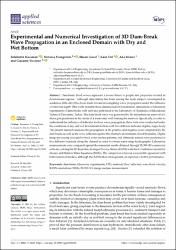| dc.contributor.author | Kocaman, Selahattin | |
| dc.contributor.author | Evangelista, Stefania | |
| dc.contributor.author | Güzel, Hasan | |
| dc.contributor.author | Dal, Kaan | |
| dc.contributor.author | Yılmaz, Ada | |
| dc.contributor.author | Viccione, Giacomo | |
| dc.date.accessioned | 2021-12-24T08:06:08Z | |
| dc.date.available | 2021-12-24T08:06:08Z | |
| dc.date.issued | 2021 | en_US |
| dc.identifier.citation | Kocaman, S., Evangelista, S., Guzel, H., Dal, K., Yilmaz, A., Viccione, G. (2021). Experimental and numerical investigation of 3d dam-break wave propagation in an enclosed domain with dry and wet bottom. Applied Sciences (Switzerland), 11 (12), art. no. 5638.
https://doi.org/10.3390/app11125638 | en_US |
| dc.identifier.uri | https://doi.org/10.3390/app11125638 | |
| dc.identifier.uri | https://hdl.handle.net/20.500.12508/1959 | |
| dc.description.abstract | Dam-break flood waves represent a severe threat to people and properties located in downstream regions. Although dam failure has been among the main subjects investigated in academia, little effort has been made toward investigating wave propagation under the influence of tailwater depth. This work presents three-dimensional (3D) numerical simulations of laboratory experiments of dam-breaks with tailwater performed at the Laboratory of Hydraulics of Iskenderun Technical University, Turkey. The dam-break wave was generated by the instantaneous removal of a sluice gate positioned at the center of a transversal wall forming the reservoir. Specifically, in order to understand the influence of tailwater level on wave propagation, three tests were conducted under the conditions of dry and wet downstream bottom with two different tailwater depths, respectively. The present research analyzes the propagation of the positive and negative wave originated by the dam-break, as well as the wave reflection against the channel's downstream closed boundary. Digital image processing was used to track water surface patterns, and ultrasonic sensors were positioned at five different locations along the channel in order to obtain water stage hydrographs. Laboratory measurements were compared against the numerical results obtained through FLOW-3D commercial software, solving the 3D Reynolds-Averaged Navier-Stokes (RANS) with the k-epsilon turbulence model for closure, and Shallow Water Equations (SWEs). The comparison achieved a reasonable agreement with both numerical models, although the RANS showed in general, as expected, a better performance. | en_US |
| dc.language.iso | eng | en_US |
| dc.publisher | MDPI | en_US |
| dc.relation.isversionof | 10.3390/app11125638 | en_US |
| dc.rights | info:eu-repo/semantics/openAccess | en_US |
| dc.subject | CFD | en_US |
| dc.subject | Dam-break | en_US |
| dc.subject | FLOW-3D | en_US |
| dc.subject | Image analysis measurement | en_US |
| dc.subject | Laboratory experiments | en_US |
| dc.subject | RANS simulations | en_US |
| dc.subject | SWEs | en_US |
| dc.subject | Tailwater | en_US |
| dc.subject | Unsteady flow | en_US |
| dc.subject | Wave front velocity | en_US |
| dc.subject.classification | Dam Break | |
| dc.subject.classification | Shallow-Water Equation | |
| dc.subject.classification | Well-balanced Schemes | |
| dc.subject.classification | Chemistry | |
| dc.subject.classification | Engineering | |
| dc.subject.classification | Materials Science | |
| dc.subject.classification | Physics | |
| dc.title | Experimental and Numerical Investigation of 3D Dam-Break Wave Propagation in an Enclosed Domain with Dry and Wet Bottom | en_US |
| dc.type | article | en_US |
| dc.relation.journal | Applied Sciences (Switzerland) | en_US |
| dc.contributor.department | Mühendislik ve Doğa Bilimleri Fakültesi -- İnşaat Mühendisliği Bölümü | en_US |
| dc.identifier.volume | 11 | en_US |
| dc.identifier.issue | 12 | en_US |
| dc.relation.publicationcategory | Makale - Uluslararası Hakemli Dergi - Kurum Öğretim Elemanı | en_US |
| dc.contributor.isteauthor | Kocaman, Selahattin | |
| dc.contributor.isteauthor | Dal, Kaan | |
| dc.contributor.isteauthor | Yılmaz, Ada | |
| dc.relation.index | Web of Science - Scopus | en_US |
| dc.relation.index | Web of Science Core Collection - Science Citation Index Expanded | |
















